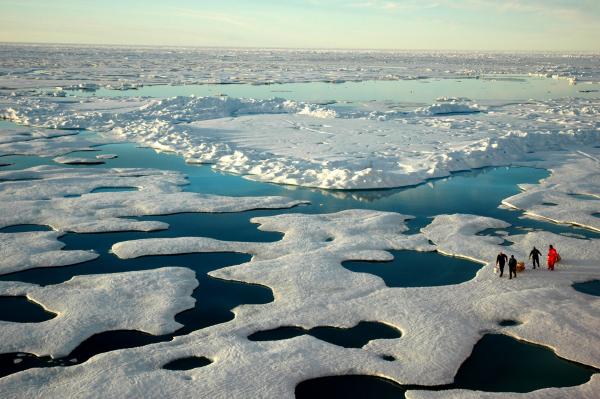
SAN FRANCISCO, Dec. 15 (UPI) — Arctic air temperatures in 2015 were the warmest they’ve been since 1900, with anomalies rising two degrees Fahrenheit above average.
The news is part of the 2015 Arctic Report Card published by an international team of scientists working with the National Oceanic and Atmospheric Administration.
Their work, shared Tuesday at the American Geophysical Union Fall Meeting in San Francisco, confirms what scientists have been saying about the arctic for some time now — that it is experiencing rapid and dramatic change as a result of global warming.
“The Arctic is warming twice as fast as other parts of the planet, which has ramifications for global security, climate, commerce, and trade,” Rick Spinrad, chief scientist at the NOAA, told attendees of Tuesday’s meeting. “This year’s report shows the importance of international collaboration on sustained, long-term observing programs that provide insights to inform decisions by citizens, policymakers, and industry.”
As the report noted, the consequences of warming air and water temperatures are evident throughout the arctic. Earlier this year, scientists measured arctic glaciersretreating at record speeds.
Sea ice shrinkage was even more pronounced. Since 1979, scientists have been measuring the surface area and reach of sea ice at its peak in the winter and its minimum in the summer. This year its peak, or maximum sea ice extent, was the smallest on record, while its minimum was the fourth smallest.
Though Greenland’s ice sheet only lost a moderate amount of ice — the advance of its widest glaciers offset the retreat of many more smaller glaciers — the melting season grew longer by 40 day in the north half of the continent, and more than 50 percent of the continent’s glaciers shrunk.
All of these changes, NOAA scientists explained, are affecting wildlife and vegetation in the arctic. But not all of these changes are well understood.
The retreat of sea ice has allowed more sunlight to reach the upper layers of the Arctic Ocean in the spring time, spurring larger blooms of phytoplankton along the edges of the continental shelf. How this trend might effect food chains in the arctic is unclear.
Meanwhile, the trend of greening arctic tundra — witnessed over the previous few decades — has ceased in recent years. More recently, arctic tundra is exhibiting increased browning. Scientists aren’t sure why.
Animals are also struggling to adapt to the rapid changes. As waters warm, subarctic fish are increasingly being found farther north. Biologists worry the influx of predators could be bad news for smaller arctic fish, like juvenile cod, who seek shelter beneath glaciers while they mature.
Likewise, walruses are increasingly flummoxed by a lack of sea ice. The conditions are forcing them to travel farther for suitable hunting grounds and disrupting their normal mating habits. Overcrowding is also a concern, as the sea mammals have been observed rushing onto beaches by the thousands as previous icy haunts melt into the sea.
Scientists say the effects of global warming are beginning to make themselves evident all over the world. But the most drastic changes, the new report suggests, are happening in the arctic. And those changes may soon have global ramifications.
“We know what happens in the arctic, doesn’t stay in the arctic,” said Martin Jeffries, an arctic scientist with the U.S. Office of Naval Research.





